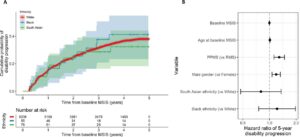
Overview
Novel Therapeutics
- New antibody preventing tau aggregation – Jin Zhou
- Small molecule drug blocking tau aggregation in Phase 3 trials – Claude Wischik
- Blocking APP generation with RNA interference – Sharon Cohen
Presentation Summaries
The approval of the anti-amyloid antibody lecanemab is an important first step in creating disease-modifying therapies (DMTs) for Alzheimer’s, but it is still a first step. There is considerable ground to cover in terms of efficacy, side effects, and ease of delivery; it is far from the cure that is needed. Here, we discuss 3 potential members of the next generation of DMTs, each of which operates in a distinct manner.
Tau Microtubule Binding Region as a possible antibody target
While the clinical trial successes of antibodies targeting amyloid plaques indicate they are providing benefits to patients, these plaques often have a poor temporal correlation with impaired cognition, and many people without Alzheimer’s are found to have them upon autopsy. Greater results might be found by targeting proteins that are more tightly linked with AD pathology.
Jin Zhou outlined how Eisai is aiming to do so as a follow-up to lecanemab. She described E2814, an antibody targeting the microtubule-binding region (MTBR) of tau. This portion of tau is believed to play a critical role in seeding tau aggregation; extracellular tau bound by this antibody gets cleared by microglia. Studies from a team led by Randall Bateman and Oskar Hansson have found that biomarkers containing the MTBR, such as MTBR-tau243, are better predictors of tau accumulation than previous tau-based markers. This linkage to tau buildup further supports targeting the tau MTBR.
E2814 is in the very early stages of testing. Zhou presented safety data from single-ascending dose (n=40) and multiple-ascending dose (n=32) studies indicating E2814 is well-tolerated. An ongoing study of 7 subjects with dominantly-inherited AD found similar safety results, as well as reduced CSF levels of MTBR-tau243. 3 months of treatment on the lowest dose provided (750 mg) reduced these levels by ~50%.
Since E2814 binds extracellular tau, Zhou stated that its benefits stem from preventing the spread of tau pathology. This would make early detection and treatment a top priority, as it is with lecanemab, as it does not impact neurons that have already begun accumulating tau.
New oral medication shows promise
The ideal vehicle for a DMT is oral delivery, the easiest delivery route that eliminates the need for trips to specialized centers for IV infusions. Claude Wischik (University of Aberdeen) presented results from a clinical trial of a drug that achieves this goal.
Wischik reported blood biomarker results from LUCIDITY Phase 3, a trial of hydromethylthionine mesylate (HMTM). This small molecule drug acts by preventing tau aggregation. Using neurofilament light (NfL) levels as a gauge for neurodegeneration, the study found that a 16 mg/day dose could effectively halt AD pathology progression over 12 months when compared to placebo (93% reduction in the rate of increase), with a similar freezing of p-tau181 levels. While this would not reverse any damage that has already occurred, slowing progression to this extent would represent a massive success for preventing additional decline. Wischik concluded his talk by teasing data to be presented later this year from the 24-month mark demonstrating that reduced NfL progression correlates with improvements in cognitive decline and brain atrophy.
Eliminating amyloid before it gets made?
The two therapeutics described above, as well as anti-amyloid antibodies, either clear aggregated proteins or prevent them from clumping. What if those proteins were simply never produced in the first place?
Sharon Cohen (Toronto Memory Center) presented interim Phase 1 Part A results for ALN-APP, which targets the mRNA that produces amyloid precursor protein (APP), preventing cells from generating the protein that is converted into amyloid-b. Such RNA interference (RNAi) approaches are in their infancy, but have proven revolutionary in treating certain rare diseases involving protein buildup. ALN-APP is the first instance of an RNAi treatment delivered to the CNS; this does come with the burdensome requirement of intrathecal administration, requiring lumbar punctures for every dose. The most common adverse events (AEs) were related to these punctures, with all AEs being mild/moderate and none requiring study discontinuation. CSF levels of the a and b forms of APP cleavage products, a proxy for overall APP levels, showed dose-dependent reductions, with the highest dose (75mg) providing 69% and 82% reductions, respectively, over 2 months.
Given the vital role that tau plays in stabilizing the cytoskeleton, this type of approach will likely be limited to APP. Nonetheless, the key role of amyloid-b in AD makes this therapy one to track over the coming years.
Conclusion
Numerous DMTs outside of the anti-amyloid antibody mold are currently being tested. Original approaches such as these will likely be necessary to discover DMTs that provide robust relief to Alzheimer’s patients – or, ideally, prevent the disease in the first place.





